----------------------------selected video art------------------------------
Listen 2 Me Work
2011
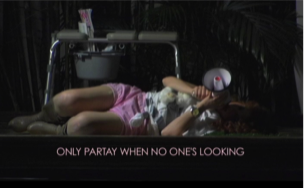
Listen 2 Me Work (7 min. 30 sec.) is a performance video about labor--that is, sitting, kneeling, reading, writing, doing something, doing nothing, consuming, and enduring. Part of my ongoing investigation of the relationship between celebrities and the State, it confronts the pleasures and pains of service work in economies of affect (otherwise known as Great Big Fun). Listen 2 Me Work was shot during Art Basel Miami Beach in December of 2010.
Bedtime Ritual for Suffragettes
(At Any Given Time, Someone in the World is Taking to Her Bed)
2011
This live networked webcam performance, originally broadcast via UStream on 4/29/2011 as part of the Low Lives 3 exhibition, uses stylized speech and a choreographed sequence of gestures to explore the ambiguity of political action/inaction. Motivated by recent protests to protect the rights of workers (broadcast as global spectacles on network news channels and on the Internet), the piece is a ritual embodying the tense relations between labor, art, movement, and taking to your bed.
139 Assisted Confessions
(After 1984 After 1984, or Confession is the Princess of Evidence)
2011
“139 Assisted Confessions (After 1984 After 1984, or Confession is the Princess of Evidence)” (11 min. 59 sec.) uses Winston’s final confession from the 1984 film adaptation of George Orwell’s classic novel as a template for my own declarations of guilt. In preparation for the piece, I removed key words from the film script. Over the course of the 4-hour online performance (edited down to a video of under 12 minutes), 5 assistants filled in the blanks in the text, providing me with a series of scripted confessions that I delivered to my webcam. The result is a darkly comic confession admitting everything or nothing.
-----------------selected live performance documentation-----------------
Forensics A-Z (series)
Forensics C (speak/don't speak)
2009
live performance
diapers, American Apparel t-shirt, high heels, water balloons, metal rings, pantyhose,
safety pin, video camera, tripod, boombox
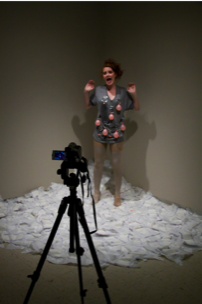
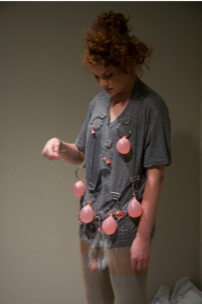
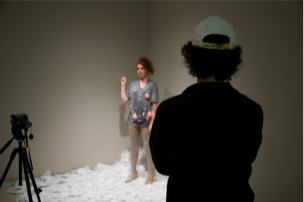
Young women in the public eye—actresses, pop singers, reality TV stars—make their living through elaborate displays of emotion. Crying on cue, wandering the streets half-clothed with frenzied expressions, and offering tearful apologies all increase a celebrity’s worth on the global image market. If women’s work is considered to be domestic labor, then girl’s work is this performance of “authentic” emotion. Girls (of any chronological age) can rise to the top through a skillfully executed emotional bender.
Forensics C (speak/don’t speak) is a solo performance that explores the relationship between young femininity and spectacular affect. Drawing inspiration from both 1970s body art and post-millennial gossip rags, I combine half-sung/half-spoken found text (including the lyrics of Lindsay Lohan’s “Speak” and Gwen Stefani’s “Don’t Speak”) with a mechanically repeated action: the popping of small water balloons attached to my clothing. The piece ends when all 10 balloons have been popped. Both cheeky and very, very earnest, I deliver my monologue to a camera on a tripod in front of me.
Forensics C was performed at INOVA Arts Center on the University of Wisconsin, Milwaukee campus as part of the Sum Total Faculty show (2009) as well as at the Hallwalls Contemporary Arts Center Artists and Models exhibition in Buffalo, NY (2010).
Forensics D (next time we hang out i will redeem myself)
2008
live performance
chocolate sheet cake, skeleton costume, football pads, microphone
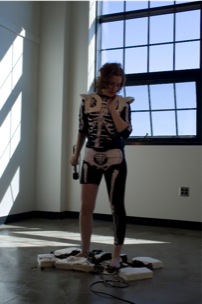
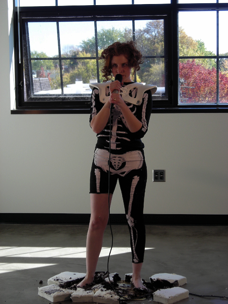
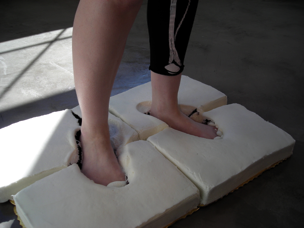
Performance is a generous offer of penance. Don’t we all enjoy standing in the corner and wearing the dunce cap every now and again? Don’t we all wish someone could be there to see it?
This performance is dedicated to Miley Ray Cyrus, one of Time magazine’s “100 Most Influential People in the World.” It is 44 minutes long, the length of an E! True Hollywood Story without commercials. Viewers are invited to watch for as long (or as short) as they like and to eat cake.
Forensics E (bad boys)
2010
live performance
pantyhose, panties, shot glasses, high heels, metal tray, 1950s bra, nurse's cap, kitchen timer, American Apparel t-shirt, paint, plywood
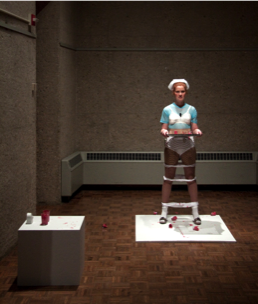
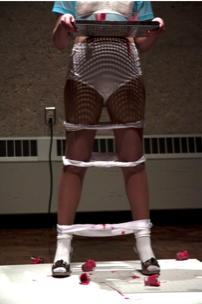
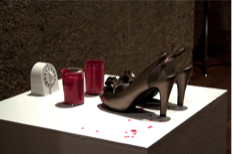
Photo credit: Kipp Zavada
“Forensics E (bad boys)” is part of an ongoing discussion about masculinity, movement, orientation, and labor. Here is a summary of this conversation:
As a response to Jackson Pollock (whether intentional or otherwise), Paul McCarthy makes Face Painting—Floor, White Line (1972), a document of an action in which the artist pushes himself along the floor while painting a white line with his face and body. Unlike Pollock, who lords above the horizontal canvas while he works, McCarthy is facedown, the pathetic, wormlike counterpart to Pollock’s vigorous, masculine (and stubbornly vertical) body.
As a response to McCarthy (whether intentional or otherwise), Franko B reclaims Pollock’s vertical orientation. Unlike Pollock, he paints with his own blood, which leaks out of his open veins as he walks slowly, naked, down a white runway (I Miss You! (2003/2007)).
As a response to the premier of the shockumentary Mondo Cane (1962)—which features a soft-core re-enactment of Klein’s Anthropometries of the Blue Period (1960)—the artist sees red. He has several heart attacks and dies three weeks later.
As a response to the artist Richard Prince, who was commissioned by W Magazine to photograph Kate Moss dressed as a naughty nurse, a furious reader writes, “A REAL NURSE would not even dream of wearing pleather or patent leather, as we would sweat ferociously with all the hard work we do.” Christie’s auction house describes Prince’s painting Lake Resort Nurse as “unit[ing] two gender stereotypes in an unlikely marriage: the macho Abstract Expressionist and the sexy nurse.”
As a response to Pollock and other abstract expressionists, Klein denies any association with the labor of action painting on the grounds that he is “completely detached from all physical work during the time of creation.”
“Forensics E (bad boys)” enters sideways into this conversation as two months of research, five weeks of half-assed adolescent patricide, and sixty minutes of failed action.
This piece was performed in the Union Art Gallery at the University of Wisconsin, Milwaukee as part of the Kate Brandt Pink group show. Kate Brandt, a video and performance artist as well as one of my former students, asked all participants to use her signature color in some way.
Forensics F (im gonna lalalove you)
2009
live performance
eye patches, custom t-shirt, American Apparel men's underwear, sock, high heels, pantyhose, fishnet stockings, wrist band, duct tape, microphone
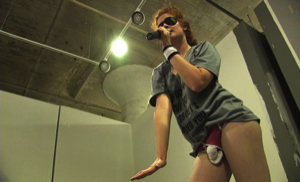
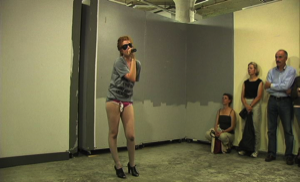
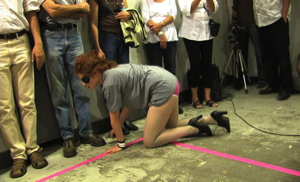
Forensics F (im gonna lalalove you (2009) is a 2-hour performance piece that combines infantile poses and military postures with blindfolded crawling, teen slang, and insecure renditions of the jazz standard Come Rain or Come Shine and the traditional patriotic song The Battle Hymn of the Republic. Forensics F was performed at the 2009 Performance Art Showcase at the Milwaukee Institute of Art and Design.
Hands on a Harder Body
2010
live performance
pantyhose, t-shirts, high heels, socks, athletic cups, headphones,
ipods, lipstick
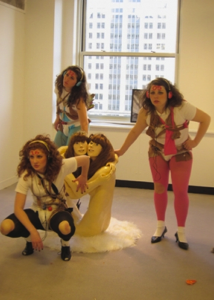
The form of this piece suggests vernacular endurance competitions (such as the one featured in the 1997 documentary Hands on a Hard Body, in which contestants tried to outlast their competitors by keeping their hands on a truck for the longest period of time), “mean girl” behavior in teen films, and 1970s endurance works by body artists such as Chris Burden, Yoko Ono, and Marina Abramović. Of course, while posing for a few hours is difficult, it is not an ordeal to be endured in the same way as Abramović’s bodily incisions. While 70s era performance artists sought to reveal to their viewers an immediate body made real through pain, I want to insist upon the mediacy of bodies made real through their presence in the image economy. I position myself within the grasp of popular culture, earnestly—even lovingly—embracing the American Brand Identity and living the teen dream. The question is, who will win the prize, what happens when that prize is art, and is winning the hardest body of all?
Hands on a Harder Body was performed at Next: The Invitational Exhibition of Emerging Art in Chicago in April of 2010 as part of HungryMan Gallery showcase. The prize pictured above--the "harder body" on which we kept our hands for several hours--was the sculpture BFFs by Elizabeth Jaeger.
Leash
2005
live performance
fabric flowers, IKEA table, rope, jersey
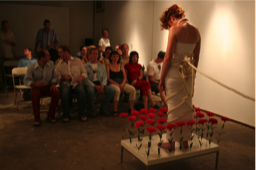
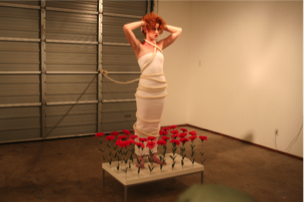
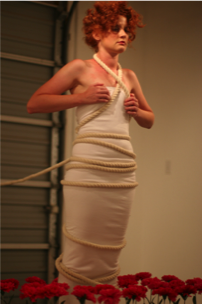
LEASH reveals the multiple convergences between four images from our cultural imaginary.
#1: ‘the girl’ as sweet, innocent, virginal, and delicate.
#2: ‘the teenaged girl’ as wild, dangerous, and oversexed
#3: ‘nature’ as fragile, threatened, and endangered.
#4: ‘nature’ as unpredictable, untamed, merciless.
Bringing these four images uncomfortably close, crossing (and double-crossing) one with the other, I invite the spectator to reconsider contemporary notions of female adolescence. LEASH explores the "fertile territory" between feral and fragile femininity through vocalized text, electronic and found sound, and stylized movement.
LEASH was performed at Iron Gate Studios in Austin, Texas in 2005.